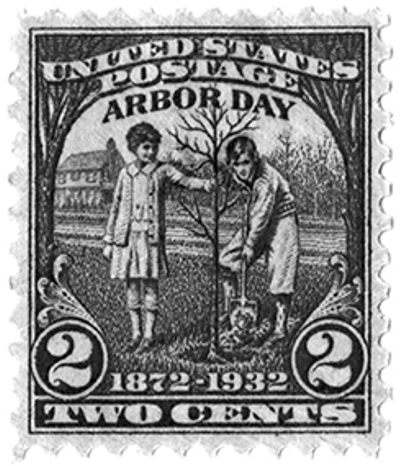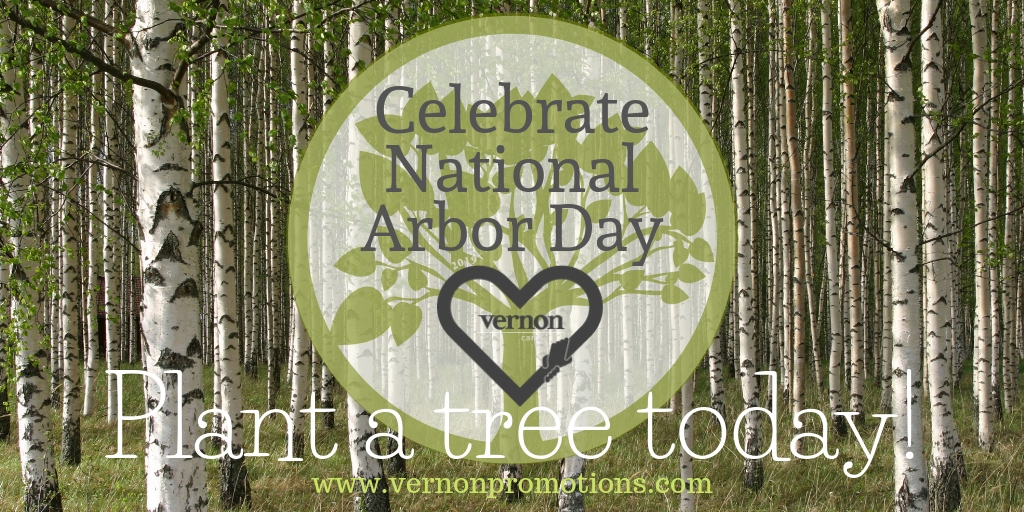Arbor Day originated in the Great Plains when J. Sterling Morton (1832-1902) and his wife Caroline Joy French moved in 1854 from Michigan to the newly formed Nebraska Territory, a land devoid of trees. He endeavored to encourage tree-planting to improve the environment and beautify the landscape to attract settlers to the area, which became a state in 1867. He carried out his work through a succession of literary, agricultural, and political positions and activities, initially as editor of Nebraska City News.
In 1872 on April 10, his idea to set aside a day for planting and calling attention to trees became the first Arbor Day, when it is said that Nebraskans planted one million trees. The birthplace of Arbor Day was Nebraska City, where the Mortons lived in their home called Arbor Lodge. In 1885, Nebraska declared J. Sterling Morton’s birthday, April 22, as Arbor Day. Eventually, J. Sterling Morton served as U. S. Secretary of Agriculture under President Grover Cleveland from 1893 to 1897.
Today, all 50 states, as well as many countries around the world, recognize Arbor Day in some manner. The day of its observance varies, depending on the best time of year to plant trees in each locale. In Illinois, Arbor Day is the last Friday of April.
Through the Morton family, The Morton Arboretum has a direct link to the origin of Arbor Day. J. Sterling’s son Joy (1855-1934) established The Morton Arboretum in Lisle, Illinois, in 1922, continuing the family legacy to plant trees. Source: www.mortonarb.org

Our 2 cents worth!
With an emphasis on going green these days, we’re all well aware of the fact that we need to recycle paper and cardboard; “Save a Tree”. But recycling isn’t enough, we need to plant more trees. Since the beginning, trees have furnished us with two of life’s essentials; food and oxygen. Today, their value continues to increase and more benefits of trees are being discovered as their role expands to satisfy the needs created by our modern lifestyles. Trees contribute more to our daily lives than you might think!
Environmental Value
Trees contribute to our environment by providing oxygen, improving air quality, climate amelioration, conserving water, preserving soil, and supporting wildlife. During the process of photosynthesis, trees take in carbon dioxide and produce the oxygen we breathe. According to the U.S. Department of Agriculture, “One acre of forest absorbs six tons of carbon dioxide and puts out four tons of oxygen. This is enough to meet the annual needs of 18 people.” By maintaining low levels of carbon dioxide, trees also lower the air temperature and reduce the heat intensity of the greenhouse effect. Trees, shrubs, and turf also filter air by removing dust and absorbing other pollutants like carbon monoxide, sulfur dioxide, and nitrogen dioxide.
Roots hold soil in place, fight erosion, and store rainwater which reduces runoff and sediment deposit after storms. This helps prevent the transport of chemicals into streams and prevents flooding.
Leaves play an important role too! Fallen leaves make excellent compost that enriches the soil and many animals eat leaves for nourishment. And the same fruits and berries that we enjoy, are also loved by many birds and other animals, which helps disperse seeds over great distances. Of course, hundreds of living creatures call trees their home.
Commercial Value
There are obvious products from trees that we use in our daily lives (paper and wood-based) but the number of wood byproducts that we use on a daily basis, just might blow your mind! Did you know that in addition to paper, cardboard, and egg cartons, paper pulp is also used for building insulation, blankets, and diapers?
Could you go a day without deodorant, perfume, plastic, toothpaste, and tape? How about shampoo and shaving cream? All of these items are made from chemicals derived from tree byproducts. Even common drugs such as Aspirin and Taxol (cancer drug) contain tree byproducts.
Cellulose fibers from trees are used to make chewing gum, rubber, rayon clothing, cellophane, adhesives, luggage, and photographic film. Who knew?
Just think of all of the food that comes from trees! Would we even want to live in a world without chocolate or almonds or cashews? How about coffee, tea, or cola? And what would Sunday brunch be without maple syrup or fruit?!?
Fun Facts about Trees
The Oak Tree is our national tree.
Thirty-six countries worldwide participate in Arbor Day.
Buildings surrounded by shade trees can save 20-50% on heating and cooling costs.
A mature tree can add between $1000 and $10,000 of value to a home appraisal.
Office workers with a view of trees report significantly less stress and more satisfaction.
Neighborhoods with more trees have less crime.
More than 20% of the world’s oxygen is produced in the Amazon Rainforest.
89% of Maine is covered in trees.
Alaska is the state with the most trees.
Trees as old as 5000 years old still stand tall in the California forests.
The largest tree in the world is a giant sequoia named General Sherman in California’s Sequoia National Park. It’s a whopping 52,500 cubic feet (1,487 cubic meters).
The National Arbor Foundation (formed in 1972) distributes some 10 million trees each year and works with the National Forest Service to rebuild our forests. The group’s donations have funded the planting of more than 20 million trees since 1990.
If you wouldn’t want to go a day without washing your hair, using deodorant, brushing your teeth, sitting at a desk, writing on paper, drinking coffee, chewing gum, wearing sneakers, eating fruit, and oh yeah….breathing air…then you should probably plant a tree today!
Learn more about Arbor Day at www.arborday.org
Blog post by Sommer Kibbee, Strategic Communications Specialist, Vernon




